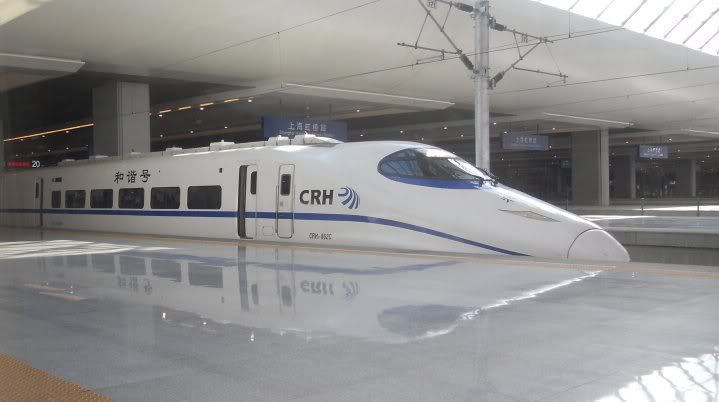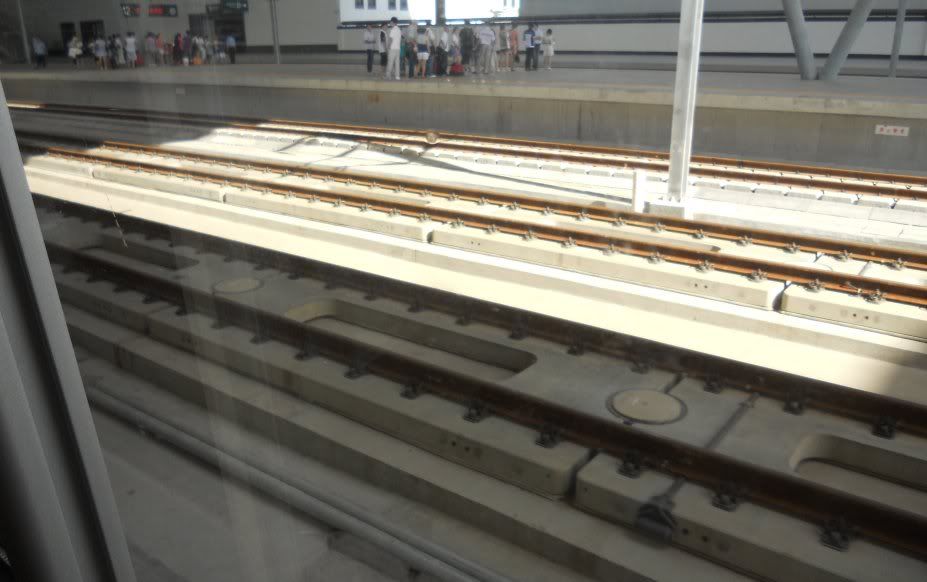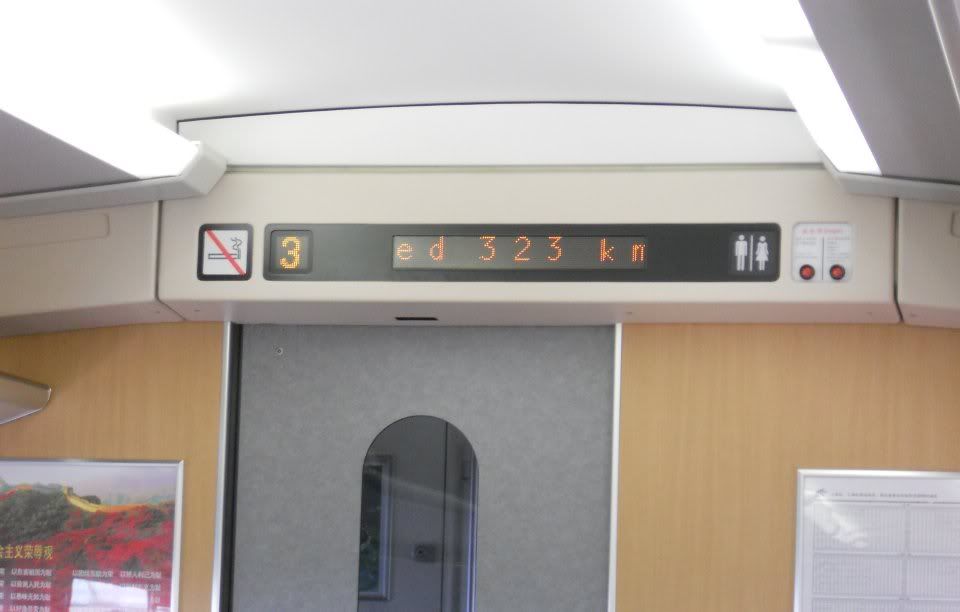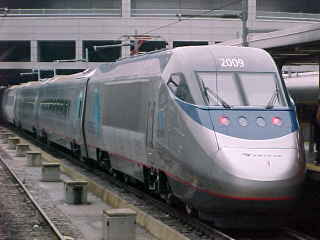
Posted on 07/25/2010 6:38:48 PM PDT by PugetSoundSoldier
There's a big push in some corners of the US transportation industry to "bring high speed rail to America". Visions of relaxed, latte-sipping trips over the nation, no lines for security, low cost trips are certainly heady ideas, but do they bear out? Let's take a critical, cold, calculating look at the reality of the situation.
As many know, I split my time between the US (Seattle, WA area) and Asia (predominantly Shanghai, China). China's been on a high speed rail building frenzy recently, and there are thousands of kilometers of line laid, with thousands more to come. Soon most of the larger Chinese cities in the East will be connected by high speed rail.
Just yesterday I rode one of these new marvels: the high speed rail line from Shanghai Hong Qiao (a behemoth of a transportation hub, consisting of an airport with two, 3400 meter runways, a bus terminal, a rail terminal, and a subway station) to Suzhou, a small town (well, by Chinese standards: only 6 million people) about 130 km away.
Hong Qiao is massive, even by Chinese standards. Not only are there 75 airline gates, but 36 long distance bus slots, 16 rail platforms, eight taxi stands (each capable of handling 800+ taxis at a time) and a full-size subway terminal. Soaring ceilings and highly polished marble and granite floors abound, and there is a good amount of space as befits China's 4th busiest airport/transportation terminal.
What does one of these new trains look like? Sleek and streamlined, as you would expect from a train capable of 300+ kilometers per hour:

These speedsters ride on some pretty specialized and dedicated rail lines, as you would expect:

Heavily bedded, full-length concrete foundations, and track ties every 20 cm. Absolute rigidity and stability is required for a train capable of such high speeds. And they do move right along:

Yes, that's 323 kilometers per hour, a hair over 200 miles per hour. It's no slouch in terms of speed! Fast, clean, relatively spacious transportation. And the ticket price of 41 RMB each way (about $6 USD) is quite cheap, too - nearly as cheap as the old, slower rail lines (which, at 26 RMB are a good discount, but take 50 minutes to cover the same distance we sped across in just 20 minutes).
So why do I say that high speed rail will not work in the US? One word:
Ridership
You see, I rode train G7130, which departed Hong Qiao on Sunday morning at 7:51 AM. And I rode train G7273 back on Sunday evening, which left Suzhou at 7:18 PM. And in each case, EVERY seat was taken, and it was standing-room-only at the ends of the cars.
Sixteen cars per train. Eighty five seats per car. And another 15-20 people standing in the baggage areas of each car. Over 1600 passengers on each train.
And there are 70 such trains a day between Suzhou and Hong Qiao. And every single one is full. Do the math - that is 112,000 riders per day on a single, 20 minute ride. And it's like that 7 days a week (remember, I rode on a Sunday and still had to buy my tickets a day in advance to guarantee a seat).
Close to 800,000 riders a week. Over 40 million a year on a single line. That's 25% more than rode ALL of Amtrak last year. And this is just a single line (not even the busiest - that title is reserved for Beijing to Tianjin, and Guangzhou to Shenzhen).
There are no discounts in China; you pay the full fare, no free tickets. That's $672,000 per day in revenue on that single train.
I talked a bit with with Wang Xiaoyan, the director of G7130 as we sped through the city. In her trademark skirt, black shoes, neatly pressed blouse, buttoned vest, and cap (with the proudly displayed "director" arm band), she provided a few details to this gao da lao wai (big and large foreigner):
China spent 23 billion RMB (about $3.4 billion USD) to deploy this stretch of track. With ridership of 35 million per year, and operating costs of 32 RMB per passenger, China expects to recover its investment in about 10 years, when the tracks need to be reworked (every 8-15 years you need to rebed and replace the tracks, to account for settling and shifting of the line).
In other words, China's doing this not because they have billions of people to move (which they do), but because it will not be an economic drain on the economy. It will cover its own costs, including maintenance.
Additionally, the construction costs are amazingly low - only $45 million per mile. Thanks to the cheap labor costs in China, and the incredibly flat terrain (Hong Qiao is at 3 meters elevation above sea level; Suzhou is at 5 meters - less than 7 feet difference, and it's completely flat between the two locations) China can build the rail for a low cost.
Consider the recent London-to-Edinburgh high speed rail line - $55 billion for 534 kilometers (note: the distance from London to Edinburgh is 331 miles, but the plan requires 1500 miles of line to make that distance a reality; you need to deploy more than just the lineal distance between locations). That's $166 million per mile, about 4 times the cost of that in China. Deploying high speed rail in the US will be much closer to the prices seen in the UK as compared to those in China, especially when you start to factor in the montainous and varied terrain in the US, as compared to most of Eastern China (and as a point of reference, Seattle's recent Link Light Rail had a cost of $179 million per mile, in line with the UK costs of deployment).
Given the plan for a 17,000 mile (27,000 kilometer) network in the US, we would see costs of $2.8 TRILLION to deploy this network (at UK line prices). A massive outlay of cash, orders of magnitude larger than that planned by China for its entire network (which already is the largest in the world, and growing rapidly).
And ridership will be lower, as well. Consider that a single segment of one line inside China eclipses all rail riders in the US. If we assumed that US ridership would increase by a factor of 10 - 300 million riders a year - and that the lines had a 25 year lifespan before being replaced (about twice what is realistic), we'd see that the per-rider capital costs alone would be $376 per trip. And this assumes 0% cost of money (interest free loans/bonds issued). No financing costs, and a 20X factor in the use of the line and we're still at close to $400 per rider per day in subsidies.
This does not include operating costs, either. Three Hundred Seventy Six dollars PER TRIP. Each of those 300 million trips each year, with a $376 subsidy tacked on.
When you run the numbers, it becomes painfully obvious why high speed rail should be shunned in the US - it simply does not make sense. We have too few people spread over too large an area, with too high of a deployment cost to make this anywhere near a reasonable approach to transportation in the US. It may make sense for a select few tiny lines (the famed NE corridor, for example), but as a realistic national network? The numbers just don't add up.
That’s only used on the stubborn ones.
Just in passing, there is more crude-equivalent kerogen in the Green River shales (and that's just one area) than in the entirety of Saudi Arabia and Iran combined. And we know how to extract it for roughly $42-46/bbl-equivalent.
"Crude equivalent kerogen" is NOT the same as crude oil itself and cannot be processed by the same infrastructure.
As depletion of traditional oil sources continues due to Peak Oil, existing processing technologies and refineries become obsolete. And we will not be able to build sufficient production capacity of kerogen processing infrastructure to provide sufficient supply to satisfy demand.
The $30 ticket is what the commission is charge of the tampa-Orlando rail project have stated.
“Your faulty analysis falsely assumes that the long term value of infrastructure assets depreciate to zero, when in reality, they will appreciate in value if properly maintained.”
Where is my analysis faulty? I’m asking you how you will pay off the cost of building the system. The numbers are simple math and demonstrate the complexity of making this kind of system self sustaining. What does ‘appreciation’ have to do with anything if too few people ride on it?
‘Furthermore, the regional economic benefits transcend what is collected as train fare. Communities serviced by Amtrak also enjoy increased economic growth that the service provides.”
Really? Cause we already have Amtrak and there aint been much economic growth because of it.
The 5 million residents is spread out in a huge geographic area. Folks on the east side of Tampa can drive to Disney in 45 minutes. I know because I’ve made the drive many times. Instead you think they’ll drive 45 minutes into Tampa so they can take a $30 trip to Disney?
Quit talking in generalities and platitudes and explain the economics of how trains such as these are feasible. Its really just basic math.
Really? Cause we already have Amtrak and there aint been much economic growth because of it.
That's because in recent decades, Florida's population and tourist industry growth have largely been fueled by highway and airport subsidies. But now that approach has become obsolete, and Florida's tourist industry risks strangulation from highway and air traffic congestion, not to mention destruction of tourist beaches and the seafood industries due to the oil addiction of highway and airline industries.
Florida needs to deploy modern energy efficient passenger rail systems as rapidly as possible or risk smothering in their own waste.
Just as I said; you haven't a clue.
Arbing vol in options is: 1) very distinctly NOT a daytrading strategy; the typical trade has a duration of 5-6 weeks, 2) there is very little or (ideally) no "gambling" involved; the strategy is pendent on locating options that are demonstrably mispriced and whose price(s) will revert to close to fair value as expiration nears, and 3) if done carefully, a vol-arb portfolio will actually have a lower beta than the broad market.
Yeah, yeah, yeah... whatever..
Arbitrage is still a short term parasitic market strategy that produces nothing of value for our society.
We'd be better off without such leeches "playing the market".
‘Florida needs to deploy modern energy efficient passenger rail systems as rapidly as possible or risk smothering in their own waste.”
Really wow, and here I thought people were moving out of Florida.
You still haven’t explained how these trains (even the Tampa one) will be economically viable? A $30 ticket will not encourage people to ride the train.
So how will these trains be economically viable.
You still haven’t explained how these trains (even the Tampa one) will be economically viable?
Because the same as with any other debt, one never really has to pay back the principle.
All that is really required is sufficient ridership to cover operating costs and make the interest payments. The debt itself can be continuously refinanced forever.
Oh, yes, and there will be an enormous lessening of sulfur problems.
Our FR colleagues whom I've pinged here can (and likely will) be able to offer hard specifics to you...not that you'll listen or understand.
Thank you for demonstrating yet another area of your utter lack of knowledge, let alone "expertise".
“All that is really required is sufficient ridership to cover operating costs and make the interest payments. The debt itself can be continuously refinanced forever.”
Have you seen how well that has worked lately? Our entire economy is in freefall because of this crap and you think its a good idea.
You’re a liberal right?
He thinks that rising steel prices would be bad for our economy, so his solution is.........raising steel prices.
Existing processing technologies and refineries become 'obsolete' on a regular basis, due to government rule changes. They must be periodically refit and inspected anyway.
As for "peak oil", I have a book When the Oil Wells Run Dry By Walter Fuchs, publishd by the Industrial Research Service in 1946...
Well, it's not exactly yet, anyway.
We're getting better at finding it, using it, processing it, extracting it, and developing the fields we find--and that doesn't count the vast areas where we aren't allowed by government to look. It'll be a while.
In the meantime, squandering our resources to build high speed rail lines based on buggy whip technology doesn't make sense. If we're oing to throw down that kind of green, let's at least go with maglev or something which won't require as much physical maintenance.
Until those technologies are ready to run on windmill power, the trains will be burning energy which could have been used elsewhere, not to mention the energy used to build the trains (and rail infrastructure needed).
Besides, did it occur to anyone the amount of CO2 released making the concrete needed to build this greenhouse gas preventing setup?
It might be fast, it might be pretty, but is it really useful? Will people use it?
As an aside, the impressive part was that there were passengers standing in the back of every rail car, at 300kph, any sudden stop will convert them into projectiles. It'd get real messy in there real quick.

It is a high speed rail that runs the northeast corridor. It flew by in a blur, and had to be going 120-140 mph easily. I couldn't believe my eyes, and I felt like an idiot for having had no idea it even existed and was up and running.
A friend I was with casually said that her husband has taken it on short business trips, and it "hauls ass and make very few stops."
Then my next thought was, "How much is that costing me?"
BTW, that is not the actual train I saw, just a pic I swiped online for illustration.
Then my next thought was, "How much is that costing me?"
Amtrak's Acela Express provides service to over 8000 passengers per day and is profitable.
It should be our objective to upgrade Amtrak's performance on the rest of its routes so that they too can be just as profitable as Acela!!!
If it is profitable, why involve the government? And why expand it to cover new areas across the country? If it was/is profitable, there should be investment capital galore just waiting to get in on the potential profit.
The sad fact is the reason it is not expanding via private investment is that it is probably not really profitable, but the feds cook the books so they can tout their success.
These are Electric Trains, and the wiring and transmission lines have to be somehow squirreled in to the existing cities, suburbs, and rural areas. Electricity is neither cheap nor "green". Somebody's burning coal somewhere so those trains can run "clean."
In claiming that the service is "profitable", Amtrak doesn't charge any of the cost of the equipment, track or other capital facilities. In government accounting, those are paid for by the tooth fairy.
Well Willie has already claimed they don’t need to be profitable, they just need to be able to sorta cover the operating costs.
Pure, unadulterated BS! The installed asset - the rails, in this case - will NEVER appreciate. The land may appreciate in value, but not the rails. Rails and wires deteriorate over time and must be replaced. They do not appreciate at all. The are, functionally, a long-term consumable of the line.
Furthermore, the land? It's an asset that you CANNOT leverage. You can leverage assets that you can possibly liquidate; you can sell the asset for the cash, or get a loan against it because the new lien holder could force you to liquidate the asset to recoup their costs.
How do you go about leveraging your right-of-way? Kind of hard to sell property for housing when there's a TRAIN that runs on it! You cannot leverage a few miles of the line because - unlike roads - you have one right-of-way that your train must use. A gap of 10 feet renders the line as inoperable as if the line didn't exist at all. It's an all-or-nothing asset.
Driftdiver's analysis was spot-on. Spend $1.5 billion to deploy the line, and at $30 a ticket you have to sell 50 million tickets. Simple division Willie, surely you are capable of that? How many people will ride this line, annually? One million? Two million? Three million (which would make it one of the most-ridden trains in the US)? Do the math again to find out how long just to recoup the initial investment (minus the time value of money), let alone cover the operating costs.
Willie, you've been smoking the good stuff again, I see...
Those are NOT "low population density areas."
Yes, they are. High speed rail only makes sense in China because we're talking 10 TIMES the density. A train from a metropolitan area of 25 million to another metropolitan area of 10 million.
Here in Shanghai, Hong Qiao airport (and train and bus and taxi and subway station) is in the Changning district. This is a "suburb-style" district of Shanghai, very low density population compared to the inner-ring area of Shanghai. And there are a 600,000 people who live within 5 km of Hong Qiao. Density on the order of 20,000 or more people per square mile.
THAT is density. Think Manhattan and go UP in density from there. That's the density required to make trains economically viable. Twenty thousand people per square mile or more.
Tampa? Around 2500 per square mile. Orlando? About 2000 per square mile. An ORDER OF MAGNITUDE lower density. The ONLY place in the US that comes close to Asian-style high density is downtown Manhattan; everywhere else is - by comparison - wide open spaces.
You really haven't a clue about the economics of trains, or you have a LOT of willful suspension of reality. Not ONCE have you ever made an economic case for trains, other than "PEAK OIL" which has been proven to be a lie...
Only because of bookkeeping accounting tricks like spreading the employee long-term benefits and track maintenance over the entire network. Amtrak counts only the direct daily cost against its ticket revenue for each line. It peanut-butters the balance across the entire network.
That's why every ticket sold by Amtrak LOSES $30+. And Amtrak's "profit" for that line (they claim about $40 per rider), at 8000 riders per day, STILL hasn't covered the $1.2 BILLION spent to install these trains. Let alone the ongoing maintenance and costs of this line. Capital costs are always ignored by train supporters.
They may want to ignore a few billion dollars on a single line, but that's the pie-in-the-sky financial lunacy that brought the US to its current crisis: ignoring the actual costs of building something, and trying to only worry about the ongoing operational costs. Those billions add up in a hurry!
Eight thousand passengers a day doesn't get you close to break-even on a new line. You have zero idea about the costs to do high speed rail. Pushing 150 MPH peak (and averaging 75 MPH - not much faster than driving) is the limit of existing rails in the US. If you want to speed it up, you need ALL NEW LINE. You'll spend (a documented) $170+ million per MILE. To upgrade the Acela Express (456 miles) you'd spend $77.5 BILLION to get it up to standards to support 200 MPH peak, and 120 MPH averages. And with 3 million riders a year, $40 per person in "profit", it would take over 6 CENTURIES to recoup the deployment costs alone.
Six hundred forty five years, to be precise.
Again, Willie, compare the ridership - 3 million per year on the Acela Express versus 90 million per year on the Guangzhou-Changsha (about the same distance) line. HUGE difference in what's needed to make it an economic reality. You can do a $15 billion line (the equivalent costs in China for their high speed rail lines) because you have 30 TIMES more riders. Suddenly that 645 YEAR payback timeline becomes a more realistic 10-12 years.
Economics is NEVER a strong suit for US high speed rail supporters. They cannot make any economic basis for their claims. It's all fantasy money, it's all fake. They have zero concept of costs, or time-value of money, of business or profit or expenses. "You have to spend your way out of a deficit" is an equivalent concept for these people...
There is no economic case to be made for passenger trains in most of America. That’s why they cannot and will not argue on that basis.
Disclaimer: Opinions posted on Free Republic are those of the individual posters and do not necessarily represent the opinion of Free Republic or its management. All materials posted herein are protected by copyright law and the exemption for fair use of copyrighted works.